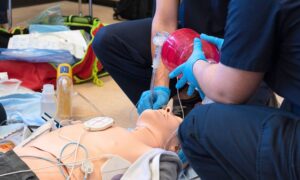A dog owner revives a ‘lifeless’ Boxer puppy who stopped breathing when her mother rolled on top of her in astonishing footage.
A man from Plum Grove, Texas, massaged the body of a tiny puppy and performs mouth-to-mouth.
A few tense minutes later, the boxer recovers her breath and rejoins her brothers and sisters to nurse at her mother’s teats.
While the man is performing mouth-to-mouth, you can hear the little Boxer puppy attempting to breath again.
In the video, you can hear the man saying “There we go! Come one!” as e continues to stroke the newborn puppy’s stomach as she lies with her mouth open.
The puppy begins to wheeze and splutter as she finally gasps for breath. The puppy originally lost her breath when her mother rolled on top of her.
The man was not sure how long the puppy was breathless for, but he began CPR as soon as he saw her looking purple.
Source: Daily Mail
Performing CPR on Pets
Many people do not know that you can use your human CPR skills on your pets. Learning how to perform CPR on you pet dog or cat can save their life in times of emergencies.
To perform CPR on a pet dog or cat, check for their breathing and their heartbeat. If you can not find a heartbeat, begin CPR with chest compressions.
According to the American Red Cross, these are the areas on which you should give chest compressions:
Cats or smaller dogs: Place the heel of one of your hands directly over the heart and the other hand on top.
Deep chested dogs: Place the heel of one hand over the widest part of the chest and the other hand directly on top.
Barrel chested dogs: Place the dog on its back, place one of your hands on the widest part of the sternum and the other hand directly above it. Lock your elbows and make sure your shoulders are directly above your hands.
“Then, push hard and push fast at a rate of 100-120 compressions per minute, compressing 1/3 to 1/2 the width of your pet’s chest. Make sure the chest comes back fully (recoils) before compressing again. Perform 30 chest compressions”
Give rescue breaths to your pet and continue CPR until your pet can begin to breath on its own.
Continue to perform CPR until you have reached the veterinary.
To effectively perform CPR on your pet, be sure to sign up for a cpr course at CPR123!







